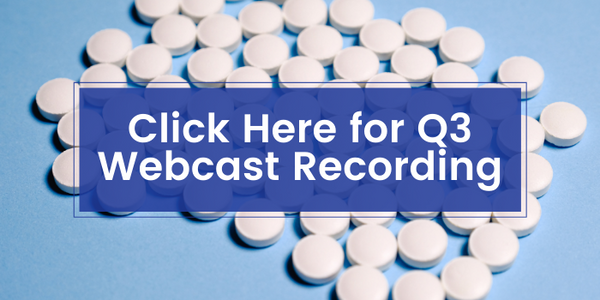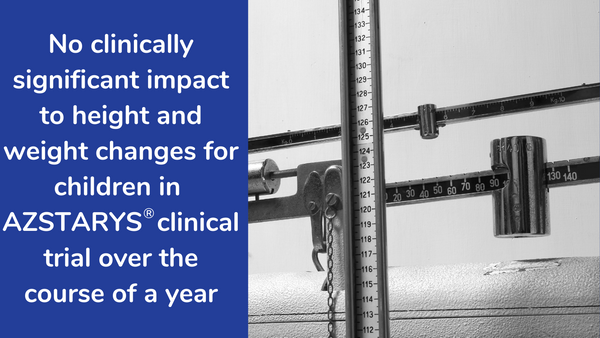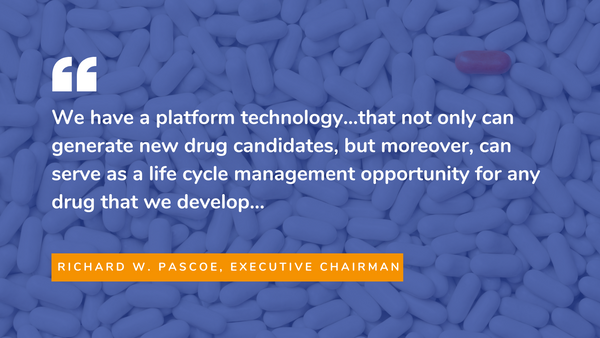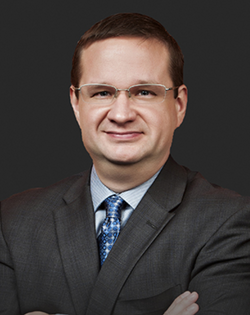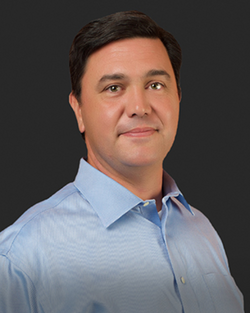
The third quarter was certainly a big and transformational quarter for the company. Our biggest news was the launch of AZSTARYS®. While we can't give a lot of details based on our agreement with Corium, we are certainly excited to share with you what has been passed along. Within the first one hundred days into the launch, they now have access to over fifty million lives that are covered by both commercial and Medicaid insurance. And that's certainly, in my experience and what I have seen, has been a tremendous win in the early days of the launch. That's certainly a remarkable achievement in such a short amount of time and it certainly speaks to the Corium team's deep experience in the managed market space.
Another highlight: We have the SDX trial that got underway in Q3, and it continues to proceed. We expect to have data available before year-end for that particular trial. From that data, we will provide more detail on the clinical development paths for SDX or SDX-related products and indications.
Again, another great quarter financially. LaDuane will report the details there, but certainly, revenue based on our consulting fees continue as well as our continued small spending until we have the resources and the budget available for our development programs.
And then, last but not least, as many of you have already seen in the press release, we continue to advance strategically forward as a company and with our board. Today (on the call) with me and LaDuane is Rich Pascoe. He joins us today as our executive chairman. He is helpful here in the office, as well as with the board. He's here to help guide our organization in the future. So, Rich, I will turn it over to you, if you'd like to say a few words.
Richard W. Pascoe, Executive Chairman: Thank you, Travis. I appreciate the opportunity to address the shareholders today. And I just want to express my gratitude to the board and to the organization for my being able to step into this new role as executive chairman. As I think everyone can attest, 2021 has truly been a transformational year for KemPharm. The team has done a remarkable job of setting into place the foundation for a strong company as we move forward. We have much to celebrate with the launch of AZSTARYS® in particular, but the board and myself believe that there's more that we can do to build value for shareholders. And my role here is to come and help assist the management team in that effort. Our goal is truly to create an opportunity for our shareholders to grow value in the company, and to do that by building a profitable, fully integrated biopharmaceutical company with multiple assets that we can take into the market.
Travis, the board, and I are all committed to creating that value for our shareholders. We believe that by continuing to build upon the successful track record of the company and developing assets, getting those products approved by the regulatory authorities and into the marketplace is critical to our long-term success. And as we look forward, we'll continue to find ways to retain the value of those assets and be able to deliver that value back to shareholders.
So, I'm just pleased to be able to be a part of the organization now in this role as executive chairman. I expect that this year will continue to be a great year for KemPharm. And moreover, I believe that as we look forward into 2022 and beyond, we'll continue to grow the organization in a way that delivers value for all of our stakeholders, including patients, the physicians that treat those patients, and our employees, and importantly those who have been with us and supporting us. We hope they continue to support us in the future. So with that, I'm just pleased to be able to assist the organization in that effort. I welcome this opportunity to be a part of that, and I look forward to the coming quarters. So with that Travis, I'll turn it back to you.
Travis Mickle, CEO: Thanks, Rich. I certainly agree wholeheartedly. And certainly, I think in line with that is one other point that we had updated in the third quarter. Tamara Seymour joined our Board of Directors, it's almost like old news. We've been working with her for months now. But a great strategic addition as well with her experiences in the past with various transactions, as well as her accounting CFO background and chair of the Audit Committee, which I know LaDuane is very happy about. Not that the previous one had any issue, which was Rich, by the way.
I'm turning now to expand upon the KemPharm value proposition. This is more about where we sit today. I think this will change and I think this will adapt. We have two approved and partnered products in which to build a company focusing on CNS neurological diseases, and as well as the opportunity to leverage our LAT® Platform Technology to create additional opportunities for the first time in our existence. So that's what we are and that's what we hope to be, at least here in the very near term.

For those that aren't as familiar with the company and the technology or if you're fairly new to the story, I'll just spend a couple of minutes going over the high-level. I just mentioned LAT® prodrug technology. It's a fairly simple general concept. We take an FDA-approved product. It's got some sort of suboptimal properties, poor PK, poor absorption, poor metabolism. We attach that to what we refer to as a ligand, and you get a new molecule from that. That new molecule has the benefit of the composition of matter of these patents, sometimes new chemical entities status. Then you administer it as directed and the same drug comes back off. So, you still have the same effective product, which gives you the benefits of a 505(b)2 regulatory path in many cases. And so, this has been the basis of which AZSTARYS® was developed and approved, Apadaz® was developed and approved. And any STX containing drug will follow a similar path.
As we look forward, this is the foundation on which we'll be able to financially do what we want to do in the future. AZSTARYS® of course, and then KP484 has already been partnered with Gurnet Point Capital as the financial partner and Corium as the actual commercialization application party. It's a portfolio company, Gurnet Point.
We have a number of SDX candidates. Gurnet Point does have a right of first negotiation and that right of first negotiation is triggered after we have our first proof-of-concept trial in May. After the 150-day window, that then flips to a ROFR. So, right of first refusal on any valid third-party offer and terminates the one-time ROFR, it terminates upon an NDA acceptance. So, if we do decide to pursue our own programs, we would do so without hindrance or impedance from GPC.
Turning briefly to the product spoken several times about, AZSTARYS®. Many of you are very familiar with this. And I hope this gives you a nice overview, if you're not, of the product. It's indicated for the treatment of ADHD in patients six and up. So, without an age restriction on the upper end. You can take this with or without food. You can actually open the capsule and sprinkle it on applesauce or water. What we're hearing back is that there's a lot of benefit to having a schedule for components here at 70% of the product. A lot of benefits to the onset and duration, but what people are resonating a little bit more than we had initially assumed is that there were no changes that we saw in our clinical trial in height and weight over the course of an entire year. And many of you may know that this is the primary concern, especially for parents of growing children. And so, I think physicians hear this feedback a lot. And this is something that they believe will have value for their patients. That's some initial feedback we're getting and I think that that certainly is captured in the label and something that Corium is messaging.
Turning now to the commercial launch. I did mention briefly at the beginning the progress that Corium has made when it comes to managed care of commercial Medicaid lives, now over fifty million. The momentum really does build and its receptivity across the board from patients and physicians, providers and now, payers. They estimate over fifty million. They think this thing will grow over the coming months. They'll, of course, plan their launch and their continued efforts around coverage.
In general, I think over the last six months or so, I've seen a lot of companies that have done recent launches. It's challenging due to the COVID-19 environment. It's due to changes in how physicians will take sales calls and get introductions. I think Corium has figured out ways around this, as many organizations have and the wins with payers are really, I think, the biggest component of where we see the future with AZSTARYS®. So, we'll keep passing along any updates that Corium will allow us to do. And, of course, we're tracking exactly what they're doing on a day-to-day basis as best we can.

I've highlighted this before, but I just want to spend a second here talking about why we're excited about this. Of course, SDX is the component in AZSTARYS®, about 70%. It's the prodrug that we've added to that particular product. It's the only Schedule IV methylphenidate-based product. All the other ones are Schedule II. This is a huge advantage for prescribers, for patients, for refills, and for pharmacists. The list goes on and on for convenience's sake. But that's also perceived to be a safer, less abusable version when you consider methylphenidate-based products.
It also has a unique PK profile, which allows for gradual and continuous release throughout the day. There's no generic equivalent and it cannot be substituted. That's, you know, by law in most states.
We recently initiated a trial with SDX under our KP879 IND. Now, if you recall, 879 is our program for stimulant use disorder. It's where we want to investigate that sort of indication. It's looking at the pharmacokinetic safety and some of the exploratory effects of what happens with SDX at high doses. Data released is still on track for the end of the year. The goal of this study is to help inform us though exactly where we want to head in the future with drug development. So, I've mentioned SUD or stimulant use disorder. We've also investigated idiopathic hypersomnia, which is a severe sleep disorder, as well as others for which methylphenidate has been used in the past.
And so, with that data in hand, what we're going to do and how we're going to make our business and clinical decisions here will be based on a number of different factors.
- Clinical risk, i.e. how likely is this to succeed.
- Development risk. What challenges may we see during the development path?
- Regulatory risk is actually something not to be underappreciated. First-time products always have a more difficult road. It's hard to convince the FDA of what your drug is doing. And even though it might be much needed, it's a difficult task in many cases.
- Commercial opportunity. This is a big part, right? We have to make sure that we're in the right space and it's going to have the right value when we come out on the other end of an approved product.
- Cost of development. If all else things are equal, you go with the cheaper choice, right? That just makes more sense. As well as the time to approval. Anything that gets there faster. We already know that SUD is a challenge because it will take longer to approve. So, all of this will be part of those considerations, as well as generally with the strategy, right? We don't want to step on our own toes with AZSTARYS®. We don't want to butt up against other products. We don't want to run into difficulties with ROFRs and Eurofins. All of those will be components of our decision.

Thank you, Travis. And good afternoon everyone. For the third quarter, we reported revenue of $2 million, which was derived primarily from service fee revenue. This is the same service fee revenue we've been reporting to you, and it's being earned under consulting arrangements with Corium that continue through March of 2022. KemPharm's net loss for the quarter is $1.8 million, or $0.05 per basic and diluted share compared to a net loss of $3 million or $0.68 per basic and diluted share in the same period in 2020.
Net loss for Q3 was driven primarily by our operating loss of $2.2 million, which was partially offset by non-capital provided adjustment income of $300,000 related to derivative and warrant liability and sum net interest income of about $100,000. Net operating loss of $2.2 million for Q3 of '21 with a month to change of about $1 million compared to the prior year, which was primarily due to an increase in operating expenses period over period. That net increase was driven by R&D expense increases of about half a million dollars due to the ongoing SDX study, which Travis has described, and an increase in other G&A expenses of about half a million dollars.

As of September 30th, cash and cash equivalents were $131.5 million dollars, which was a decrease of about $800,000 compared to June 30th, 2021. A little better than what I've told you our burn rate has been. And so, we continue to be prudent and manage that wisely. As of September 30th, total shares of common stock outstanding was 35,317,313 shares. And fully diluted common shares were about 46.5 million shares, which includes warrants outstanding of $4.2 million.
Our financial position remains strong as a result of the restructuring and recapitalization effort completed earlier this year. This cash balance provides us with the flexibility to consider the best opportunities, most in both internal and external, to leverage our position and drive growth and shareholder value.

The Global Select Market, which comprises only 1,450 stocks, is recognized as having the highest initial listing standards of any exchange in the world and is considered a mark of distinction among public companies. In order to qualify, companies must meet strength, financial, and liquidity requirements. And as well as corporate governance standards on both an initial and continuing basis.
Strategically, moving up to the NASDAQ Global Select Market provides the opportunity to introduce KemPharm stock to a new echelon of potential investors, particularly those who only consider investments in companies on that exchange. This is an exciting development and one that we expect will provide benefits both now and in the future.
Travis Mickle, CEO: Thanks, LaDuane. Just looking ahead, wrapping up here. Certainly, we're very encouraged with the Corium launch. We believe that they're deploying their sales team and their efforts in the right places. And the focus on managed care and access is absolutely the highest priority. Early days you want to make sure that those scripts that are written are filled and so, they continue to be written. And there's no kickback back to the position which causes unnecessary difficulties for them. We do expect to have the data from the SDX trial before year-end. We also expect to be able to provide a pathway forward based on that data.
Our cash on hand, our potential for future revenue, provide us with a really unique and strong position to act strategically, to think beyond the walls of KemPharm, and to think about what opportunities we have internally. And so, beyond AZSTARYS®, the lead product candidate that we'll move forward with is SDX. We should be able to certainly plan this as early as January, right after the data comes. We will continue the ongoing evaluation of non-SDX candidates and external opportunities are ongoing. And certainly, you know, cash and future revenue. All the great data that we have will support those efforts.

Question 1: Given the favorable DEA Schedule IV for SDX, when will we know the details of your new expanded development plans for KP879 or a different product candidate using SDX as its sole API, which you hinted at months earlier?
Travis Mickle, CEO: Well, I think we've covered this a number of times already, but just for clarity's sake, anticipate having the data for the trial by the end of the year. That will allow us to actually hone in on the plan and prioritize what products to advance. Now, it's unique because it gives us multiple opportunities. So, maybe there are one or more opportunities. So, we certainly want to identify which one of those where you could build a franchise around this unique SDX product.
Question 2: What has the early launch taught you about the receptiveness of the market towards AZSTARYS®?
Travis Mickle, CEO: Indications from Corium, including the update provided in the press release and here in the call itself as to the payer penetration, really suggested the rollout is going very well and according to their expectations. I think Corium’s plan is smart and is carefully orchestrated to maximize resources towards near-term opportunities that will build a foundation for sustained success. Certainly again, I'll reiterate we are very encouraged by the recent news and we'll see where the prescriptions are tracked in the coming months.
Question 3: At what point in development must Corium act upon its first Right of Refusal or Right of First Negotiation for future products or lose that right if it doesn't act by then?
LaDuane Clifton, CFO: Travis, I'll take this question. It's really initially for SDX-based products, there's a Right of First Negotiation. So, when we have a new product candidate and we run a study, we have to provide it to Corium and then they get a 150-day evaluation period to consider the data and decide if they would like to license the product or at least make an offer to do so.
Now, KemPharm does not have an obligation to accept an offer from them at that point in time. So it can just run along, either we meet terms or we don't, it just depends on all the criteria that Travis has outlined and all the strategic considerations we would take into account.
So, at any rate, that right remains until the point when, for that particular product candidate, an NDA has been accepted. And so, at that point, that Right of First Negotiation ends. Now with regard to a Right of First Refusal, think of it as kind of coming second in succession if you will, because that's really something that would be triggered only if there's a bona fide third-party offer to license one of the product candidates covered by the license agreements.
So, in that case, then you've got a third party that's expressed interest in licensing, perhaps, we have to provide the terms of such an offer to GPC, the team there. And now they have a 30 business day opportunity to evaluate that and decide if they want to match the terms and therefore step into the shoes of that third party and license that product candidate.
That right, again, there – none of these rights exist following NDA acceptance and once they've really decided not to exercise a ROFR, we can move forward with that third party, and there are no additional rights for GPC at that point. So, this process can take place more than once, because, technically, there could be more than one SDX-based product candidate that comes out.
So, hopefully, that provides additional details and color around those. I'd say that, particularly in the Right of First Negotiation, KemPharm maintains a lot of flexibility and makes sure that we only accept offers that we think are in the best interest of shareholders and our strategic objectives.
Travis Mickle, CEO: I just one point of clarity that the ROFR, actually, is not bound in time to the ROFN. It could happen at any time a valid third-party offer comes in. Is that correct?
Question 5: I was wondering if you could maybe talk a little bit about the ongoing review of the SDX data. Is any efficacy being measured in the proof-of-concept SDX trial currently going on? How much have you shared with Corium and continue to share with them? And also, have you had any additional discussion with them on the data set?
Travis Mickle, CEO: The ongoing trial is designed to investigate several of the properties of SDX, including the pharmacokinetics of high doses, safety, additional kinds of efficacy, and effects in an exploratory fashion. This data should then inform what to prioritize, what to move forward first, and what other indications may be possible.
The next step is to pinpoint what we want to move ahead with and what the timeline looks like, as well as the value proposition. So, our initial early data is exactly what was expected on how SDX performs pharmacokinetically. There's absolutely no surprise there. But that data now must be paired with the additional pharmacodynamic data or the effect data. And then the safety in order to decide what clinical path and indication should be advanced first. So, in terms of Corium, we do keep them well informed. They know what's going on. Once we have data available for any clinical candidate, we'll provide that to them as a proof-of-concept, which then would initiate the ROFR – ROFN process.
Question 6: Based on current information, when do you think you will be able to file an NDA for IH and SUD? Is there any special designation for either of those programs from the FDA possible?
Travis Mickle, CEO: Yes. It'll be based on the full analysis of when the timing is. It's difficult without that to determine exactly when you would file an NDA. And that's usually a few years out, so you want to be cautious and exactly what that timeframe looks like. As far as designations from the FDA, for both of these spaces, they're certainly applicable for a fast track designation. Breakthrough therapies are a possibility depending on the data you see in the clinical studies, but I think in the case of IH, that's one where you would have an orphan drug designation possibility. This is an orphan disease, a rare disease, and other products have received it for IH.
Question 7: What impact could AZSTARYS® have on potential future SDX products, both from a development and commercialization standpoint?
Travis Mickle, CEO: I believe, and I think, it kind of makes a lot of sense that AZSTARYS® certainly has a positive impact on the development of future SDX products in that you're going to have more data available to provide the FDA regarding the clinical program of whatever you're doing. And you'll have data available for CMC, as well as nonclinical data that could be generated.
From a commercial standpoint, it goes into one of our strategic considerations. We don't want to step on our own toes. So, we don't want it to overlap or go up against indications that are already going to compete with AZSTARYS®, especially if they're in a rare disease that may command a higher price point and AZSTARYS® could encroach on their space. So, we do want to make sure we announce and proceed ahead with a lead program where these two fit distinct and unique markets.
Question 8: The last call indicated difficulty in receiving accurate numbers from insurance companies. When can a real-time holistic report on insurance companies approving scripts or sales for AZSTARYS® be anticipated? Are the current script numbers reported by Symphony or available on Bloomberg accurate?
Travis Mickle, CEO: Well, I think there's kind of two parts to this question. One is Corium gave us the answer, all right. Over 50 million lives, as of today, are covered both for commercial and Medicaid. I think the second part of that is really about these tracking mechanisms and scripts.
So, it really doesn't help if you have a small number of scripts. It's going to be those who rely on estimates of those tracking. And so, you're going to be very subject to a lot of error. As you get more and more scripts, that's when they become more and more reliable. So, we're not quite there, I would say, but we're getting there. And especially with this access number.
Question 9: Now that you've restructured the balance sheet and have a solid cash position, is KemPharm considering any next possible steps, such as the share repurchase program?
LaDuane Clifton, CFO: I think it's something that we've seen actually – and received a number of questions related to. I'll just say, I think the best way to answer this question is really to focus on the strategic rationale for why we restructured our finances? Why was it important that we strengthened the balance sheet and have a better cash position?
Ultimately, this was done to fuel KemPharm's long-term growth by providing the capital we need to invest not only in our current business and our ongoing development activities, but also allow us to consider external opportunities. In any event, all of those considerations are always designed to answer the question, how can we best invest so that we create shareholder value? And so, ultimately that's always what we're focused on. Does a share repurchase program meet those goals? Well, at this point we haven't announced one and I'm not certain it does, but we will always be considering the right way to return to a shareholder. So, I think with that, hopefully, that helps address it, but certainly, I believe we do have a lot of good opportunities in front of us yet to be considered.
Richard W. Pascoe, Executive Chairman: Yes. I'd just like to add a few thoughts here. I mean, first of all, I think if you look at the company right now, you look at the value proposition the company already has in its possession. We have a – what I think is a best-in-class ADHD drug that's generating revenue for the company. So, we have a revenue stream that we can look forward to. That's rare in this business, as you know.
The company's batting a thousand on NDA approvals. Again, it's very rare in this industry to get one drug approved as a small company. We have two, and that's been a track record that we can continue to be proud of and build upon. We have a management team and an organization that's very capital efficient. Thanks to Travis and LaDuane, we have been able to build a strong team that's capable of developing, gaining regulatory approval, and partnering assets. And that's been a strategy that's worked for us to date. And we have a platform technology that you're familiar with that not only can generate new drug candidates but moreover, can serve as a life cycle management opportunity for any drug that we develop ourselves or even look to bring in and do for someone else.
Having said all that, we can do better as an organization. We know how to get drugs approved. We have a strong balance sheet. We have a team in place that can make it happen. We have a pretty good track record when it comes to licensing and partnering, but I think what the board thinks and what we're going to be focused on, from a value creation standpoint, is building out a pipeline that extends beyond what's currently on the table. And to do that in a way, whether it's through our internal resources and internal product candidate opportunities, or that we do that externally is to be determined.
But if we can do that, and do that in a disciplined way, and we can expend resources in a thoughtful way, we can be very strategic with respect to building out a pipeline so that we stay close to where we understand and know markets and develop strategies to be able to be successful yet again, from a regulatory standpoint.
And then, we can retain value in those assets to the point where we can truly attract the sort of strategic interest in the company that I think everyone is looking forward to. And we can grow and build the organization, not only from a balance sheet standpoint but from a stock price standpoint. That's the goal here. That's why I'm here. That's why the Board is squarely behind this effort to take the unique situation that we're in right now, with a company that's never been stronger. We can do better. We can do more. And we’re going to continue to do that. We're going to do it in a thoughtful way. And so, I just really want to express my gratitude to the team here. Sincerely I want to express my gratitude to the shareholders out there who have been supporting us, many of whom have been supporting us since day one.
Thank you.
KemPharm is a specialty pharmaceutical company focused on the discovery and development of proprietary prodrugs to treat serious medical conditions through its proprietary LAT® (Ligand Activated Therapy) technology. KemPharm utilizes its proprietary LAT® technology to generate improved prodrug versions of FDA-approved drugs as well as to generate prodrug versions of existing compounds that may have applications for new disease indications. KemPharm’s prodrug product candidate pipeline is focused on the high need areas of attention deficit hyperactivity disorder, or ADHD, stimulant use disorder (SUD), and CNS rare diseases, including idiopathic hypersomnia (IH). In addition, KemPharm has received FDA approval for AZSTARYS®, a new once-daily treatment for ADHD in patients age six years and older, and for APADAZ®, an immediate-release combination product containing benzhydrocodone, a prodrug of hydrocodone, and acetaminophen. For more information on KemPharm and its pipeline of prodrug product candidates visit www.kempharm.com or connect with us on Twitter, LinkedIn, Facebook and YouTube.
This press release may contain forward-looking statements made in reliance upon the safe harbor provisions of Section 27A of the Securities Act of 1933, as amended, and Section 21E of the Securities Exchange Act of 1934, as amended. Forward-looking statements include all statements that do not relate solely to historical or current facts and can be identified by the use of words such as “may,” “will,” “expect,” “project,” “estimate,” “anticipate,” “plan,” “believe,” “potential,” “should,” “continue” or the negative versions of those words or other comparable words. Forward-looking statements are not guarantees of future actions or performance. These forward-looking statements, including the continued commercialization of AZSTARYS® and the further development of KemPharm’s pipeline of product candidates, are based on information currently available to KemPharm and its current plans or expectations and are subject to a number of uncertainties and risks that could significantly affect current plans. Risks concerning KemPharm’s business are described in detail in KemPharm’s Quarterly Report on Form 10-Q for the quarter ended September 30, 2021, and KemPharm’s other filings with the Securities and Exchange Commission. KemPharm is under no obligation to, and expressly disclaims any such obligation to, update or alter its forward-looking statements, whether as a result of new information, future events, or otherwise.

